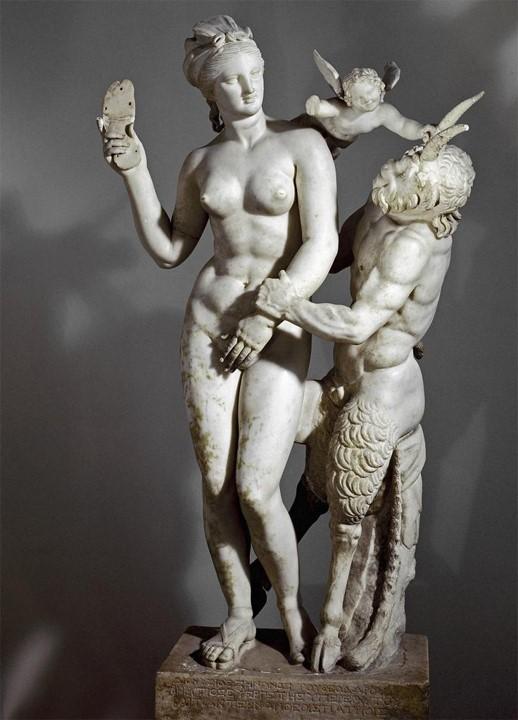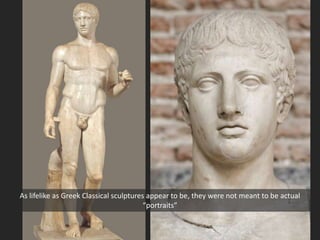Their portraiture sculpture is regarded as the best sculpture of. Polykleitos Spear Bearer Classical art that emphasized rational simplicity order and restrained emotion.
Were developed in the late fifth century BCE.

. Temples and other public buildings. The sculptures of this later period are moving away from the Classical characteristics they still. Indeed John Boardman describes the work of Polyclitus Fig 2 a sculptor who canonized the male athletic body in classical period art as ideally realistic Boardman 157.
The origin of sculpture in Greek and Roman art can almost be divided into distinct categories- classical and idealistic vs naturalistic and emotional sculpture work. Classical Greek figures appear more relaxed than the rigid formal Egyptian and early Greek sculptural poses because _____. The classical period characterized modifications in both the function and the style of the sculpture.
Classical Period 480-323 BCE Art produced during this period was considered the finest of the finest. 1601-02 oil on canvas 107 x 146 cm Sanssouci Picture Gallery Naturalism is resemblance to the real world as we see it around us. Prior to the influence of Greek sculpture Roman sculpture was portraiture sculpture busts.
After mastering the portrayal of naturalistic bodies from stone Greek sculptors began to experiment with new poses that expanded the repertoire of Greek art. Classical Greek sculpture is both naturalistic and idealistic. Caravaggio The Doubting of Thomas c.
During the classical period Greek sculptures did what no one had done before by worshiping the human body through bronze and The sculptures were both human-size and human-like. Create an account to start this course today. The only materials available to the Egyptian sculptors were stones that had a very.
For details of art movements. Art of Ancient Greeces Classical Period. The sculpture of the ancient Greeks had a major impact on.
The Classical period saw changes in both the style and function of sculpture. Hellenistic Greek sculptures are often describes as naturalistic emotional and dynamic. The scientific skill of Greek sculptors in showing the human form in distinct poses was improved.
Played a major role in the daily lives of the people of ancient Greece. The more naturalistic a work the more it looks like our world and the less naturalistic the less so. The Archaic period of Greek Sculpture was known for its stiff expressionless subjects.
Classical Greek sculpture is both naturalistic and idealistic. Poses became more naturalistic see the Charioteer of Delphi for an example of the transition to more naturalistic sculpture and the technical skill of Greek sculptors in depicting the human form in a variety of poses greatly increased. Classical Greek sculptors were more imaginative because the Enlightenment released them from the dogma of the pharoahs.
Classical sculpture was both naturalistic and idealistic Government assembly halls The first Christian churches were patterned after basilicas used by he Romans as. The Greeks and Romans both represented gods and rulers in the form of statues a combination of religious and political influence. Their sculpture was predominantly portraiture see below until from the 1st century AD the Romans adopted Hellenistic sculpture which took sculpture to a different level as a model for their own sculpture.
No longer did Ancient Greek sculpture represent ideal beauty and perfection the way it had during the Classical period. Poses seemed more naturalistic as shown by the Polykleitos of Diadumenos sculpture. Naturalism realism abstraction and idealization.
A similar conflation can be found in the medium of classical sculpture which is both naturalistic and idealistic. Beautiful natural looking images of men and idealized images of Gods. Classical Art Art that was both Naturalistic and idealistic.
Annibale Carracci 1560-1609 influenced by Federico Barocci1526-1612 and others produced an idealistic naturalism based on Classical models and though he could depict everyday scenes with remarkable truth his world is an idealised one based on the Classical concepts of. 3 points QUESTION 25 1. From about 500 BC statues began to depict real people.
Defined by a careful observation of nature a new concern for the mechanics of the body and the pursuit of ideal forms Classical Greek sculpture represents a radical departure from the compact forms and upright poses of Archaic male nudes. Can be seen on the Temple of Athena Nike built on the Acropolis between 427 and 424 BCE.

Classical Greek Sculpture Is Both Naturalistic And Idealistic True Or False Study Com

Art History Midterm Flashcards Chegg Com

Form And Reality The Classical Greek Balance Of The Ideal And The Natural Disrecognized Space

On The Literature And Thought Of The German Classical Era 11 Laocoon In Germany Open Book Publishers



0 comments
Post a Comment